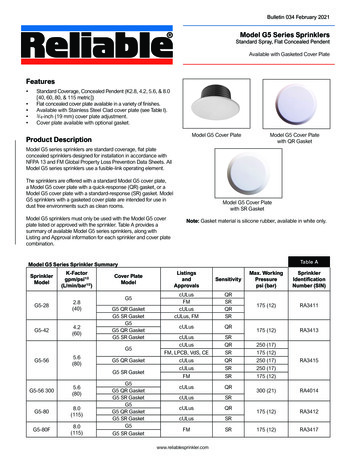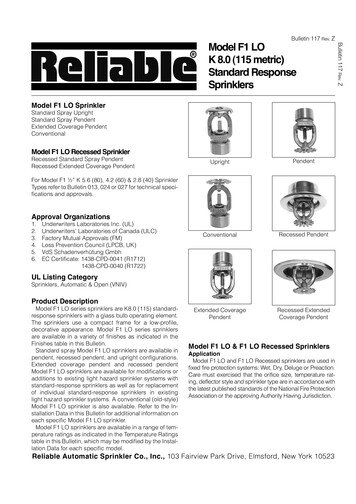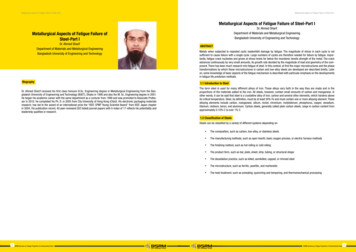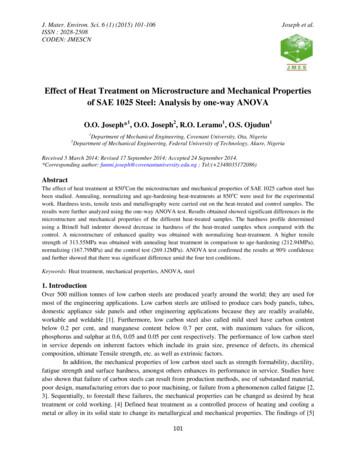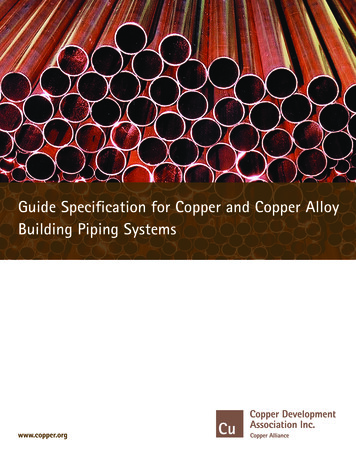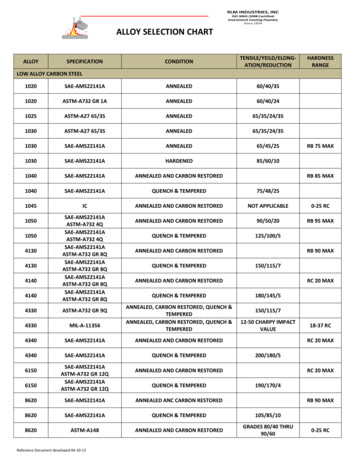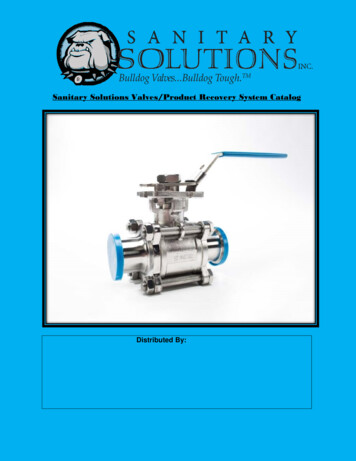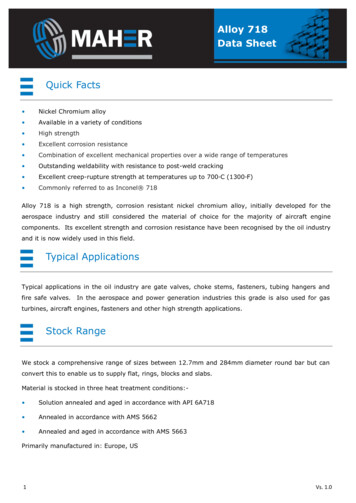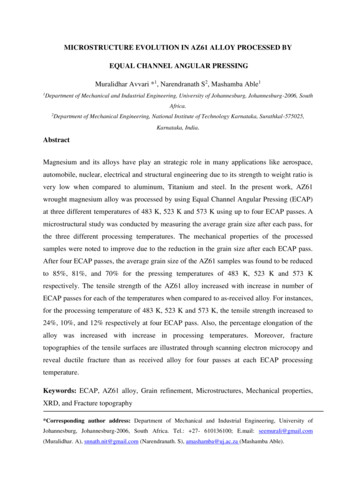
Transcription
MICROSTRUCTURE EVOLUTION IN AZ61 ALLOY PROCESSED BYEQUAL CHANNEL ANGULAR PRESSINGMuralidhar Avvari *1, Narendranath S2, Mashamba Able11Department of Mechanical and Industrial Engineering, University of Johannesburg, Johannesburg-2006, SouthAfrica.2Department of Mechanical Engineering, National Institute of Technology Karnataka, Surathkal-575025,Karnataka, India.AbstractMagnesium and its alloys have play an strategic role in many applications like aerospace,automobile, nuclear, electrical and structural engineering due to its strength to weight ratio isvery low when compared to aluminum, Titanium and steel. In the present work, AZ61wrought magnesium alloy was processed by using Equal Channel Angular Pressing (ECAP)at three different temperatures of 483 K, 523 K and 573 K using up to four ECAP passes. Amicrostructural study was conducted by measuring the average grain size after each pass, forthe three different processing temperatures. The mechanical properties of the processedsamples were noted to improve due to the reduction in the grain size after each ECAP pass.After four ECAP passes, the average grain size of the AZ61 samples was found to be reducedto 85%, 81%, and 70% for the pressing temperatures of 483 K, 523 K and 573 Krespectively. The tensile strength of the AZ61 alloy increased with increase in number ofECAP passes for each of the temperatures when compared to as-received alloy. For instances,for the processing temperature of 483 K, 523 K and 573 K, the tensile strength increased to24%, 10%, and 12% respectively at four ECAP pass. Also, the percentage elongation of thealloy was increased with increase in processing temperatures. Moreover, fracturetopographies of the tensile surfaces are illustrated through scanning electron microcopy andreveal ductile fracture than as received alloy for four passes at each ECAP processingtemperature.Keywords: ECAP, AZ61 alloy, Grain refinement, Microstructures, Mechanical properties,XRD, and Fracture topography*Corresponding author address: Department of Mechanical and Industrial Engineering, University ofJohannesburg, Johannesburg-2006, South Africa. Tel.: 27- 610136100; E.mail: seemurali@gmail.com(Muralidhar. A), snnath.nit@gmail.com (Narendranath. S), amashamba@uj.ac.za (Mashamba Able).
1. IntroductionConventional metal-working processes such as drilling, milling, turning, casting, forging,rolling and extruding are the main industrial processes used in the manufacture of metalcomponents. These conventional metal-working processes rely on localized plasticdeformation of metals during material removal and forming. The final metal componentsfrom such conventional processes tend to have very similar mechanical properties as those ofthe parent unprocessed work-pieces. When superior mechanical properties are desired in thefinal metal component, non-conventional techniques that rely on severe plastic deformationduring processing are used.Severe plastic deformation (SPD) techniques are a group of metal forming processes thatinduce large strains, complex states of stress and high shear during processing to producecomponentsthathavenano-crystalline nelultra-fine grain sizesangularpressingand(ECAP),Accumulative roll bonding (ARB), High pressure torsion (HPT), Mechanical Alloying (MA),and Asymmetric Rolling (ASR) are few techniques using in manufacturing industries so faramong other SPD techniques.In this paper, the ECAP metal-working technique is used to evaluate its effects on themechanical properties of the AZ61 (Al-6.5%, Zn-1%) alloy at different processingtemperatures. The ECAP technique is a new process that is capable of making uniformplastic deformation in a multiple materials without affecting any significant changes in theirshape or cross sections in materials [2]. ECAP will allows the severe plastic deformation inbulk materials through its multiple extrusions. Also, complex microstructures and texturescan be developed by changing the orientation of the billet between successive extrusionspasses in ECAP [3]. Venkatachalam et al [4] produced desirable mechanical properties in test
samples of 2014Al by using different processing routes. Author has been concluded that themaximum deformation obtained in route Bc, where the specimen was rotated 90ºcounterclockwise after each pass. Valiev and Langdon [5] reported on aluminum usingdifferent die angles to study the mechanical improvements in material. Molnar and Jager [6]studied material behavior at different temperatures using die angle 90º and arc of curvature45º. Valive et al (2006), concluded that the two and four ECAP passes provides maximummechanical properties and then after 32 pass only could observe the slight improvements inproperties [5]. Hence, in the present work, results were concluded up to four ECAP passes toreduce the cost of the product.In this paper, AZ61 magnesium alloy was used as a material because of its highstrength-to-weight ratio, and good formability [7]. The AZ61 alloy has been used in manyindustrial applications as structural parts in aero-space, automobile, nuclear industries [8].However, magnesium and its alloys cannot be easily processed at ambient temperatures likeface-centred cubic (FCC) and body-centred cubic (BCC) structured materials. Magnesiumand its alloys have a hexagonal close packing (HCP) structure such that their slip systemsactivation at room temperature is insufficient to accommodate uniform plastic deformation ofmagnesium alloys, which can be considered as a major limitation [9]. Many authorsconducted their SPD metal-working experiments on magnesium alloys using a single selectedhigh temperature [10,11]. However, very few papers has been found that use and compare theeffect of different ECAP processing temperatures on the mechanical properties and microstructure of magnesium alloys [6]. Mechanical properties of the material can be improved bychanging the size of the grains by varying the heat treatment processes. Hence, the mainobjective in the present work is to enhance the mechanical properties of the AZ61 alloy atdifferent temperatures as suggested by R Z Valiev.2. Experimental Work
The outline of the ECAP process was planned with two equal channels, traversing atparticular angles called the die angle ( ) and the arc angle ( ) subtended at the channelsintersection as shown in fig.1 [10]. In the present work, ECAP die is designed with a dieangle of 120º and arc angle of 30º to reduce the dead zone of material. Here, the extrusionspeed was taken as 2 mm/sec throughout the experimental work.Fig. 1. Working principle of Equal Channel angular Pressing [10]A commercial AZ61 alloy rod was machined into experimental samples having a diameter of16 mm and a length of 80 mm. Machined experimental magnesium sample rods werehomogenized at 673 K for 24h to remove the intermetallic heterogeneities that were presentin the alloy [11]. Experiments were carried out using four ECAP extruding passes at threedifferent temperatures of 483 K, 523 K and 573 K for route Bc (where, the specimen rotates90º counter clock-wise direction at each successive pass). Among all fundamental routes,route Bc proves that the better deformation could be achieved which intern to increase inmechanical properties [4]. In this work, experiments were tried to perform at belowrecrystallization temperature (around 473 K) of magnesium and its alloys. But, as shown in
the fig. 2, the results were found to be many broke pieces at room temperature, broke andcracked surface at 373 K, and cracked surfaces at 423 K without using any external pressures.At room temperatureAt 373 K(a)At 473K(b)At 483 K(c)(d)Fig. 2. ECAP processed AZ61 alloys after first pass at different temperatures. (a) At Roomtemperature (b) 373 K (c) 473 K and (d) 483 KFor each ECAP pass, heating plates were arranged around the die to provide designatedtemperatures. Specimens were held in the channel for the same temperature in order to reachstabilization between the die and specimen. Graphite was used as a lubricant to reduce thefriction between die and specimen. The preparation of sample for testing involves mechanicalpolishing using different SiC papers. In addition, the colloidal Al2O3 and diamond paste wereused to achieve mirror surface finish. Picral reagent was used to etch the polished surface ofthe sample to observe the microstructure [11]. Microstructure study was carried out by linearinterception method to know the grain size of AZ61 alloy using an image analyzer (BIOVISSoftware). Hardness test was done using Vickers micro-hardness test rig by applying load of100g with a significant time 13 seconds. On an average, 10 hardness tests were performed oneach sample to obtain accurate hardness of AZ61 alloy. Tensile test specimens were prepared
as per ASTM E-8 standard following the gauge length of 15mm and a diameter of 5mm. Thethree average tensile tests were carried out using a Hounsfield Tensometer to analyze thetensile properties of AZ61 alloy.3. Results & Discussion3.1 Effect of ECAP at different processing temperaturesIn the results and discussion, Optical Microscope (OM) characterization, and mechanicalproperties have been evaluated for AZ61 alloy at three different processing temperatures of483 K, 523 K and 573 K for the four ECAP passes. Also, fractured surfaces of AZ61 alloyhave been analyzed and explained its behavior before and after four ECAP processes.3.1.1 Microstructure analysis(i)OM Images
Fig.3 OM images of (a) As received AZ61 alloy at room temperature; (b) Homogenized at673 K; (c) and (d) After two and four ECAP passes at 483 K; (e) and (f) After two andfour ECAP passes at 523 K; (g) and (h) After two and four passes at 573 K.Fig. 3(a)-(h) shows the optical images of AZ61 alloy as received, homogenized at 673 K, andafter two passes and four passes ECAP processed specimen structures at different processingtemperatures of 483 K, 523 K and 573 K for route Bc. All microstructural images have beentaken from the cross sectioned surface. The average grain sizes of the alloy was measured atdifferent temperatures up to four passes. In the as received material, a large number of coarsegrains were visible along with grain twins as shown in Fig. 3(a). These are expected toincrease the twinning stress, and these twinning stresses get accommodated on the grainboundaries, thus supporting plastic deformation in the alloy.In addition, the sheardeformation occurs in only one direction due to grain twinning [12]. After homogenization,the grain size was reduced while the grain count increased at the higher temperature of 673K, for a soaking time of 24h as shown in fig. 3(b). In Fig. 3(c)-(h) the grain size was greatlyreduced after shear deformation in the second and fourth ECAP passes at 483 K and 523 Kfor route Bc. The grain size reduction in the ECAP processed samples depends upon the
dynamic recrystallization [13]. But in the higher processing temperature at 573 K thereduction in grain size is minimum as compared to other processing temperatures. Fig. 3(g)(h) shows clear bimodal structure because of increasing the number of passes at higherprocessing temperatures.3.1.2 Variation of grain size with different processing temperatureFig. 4 shows the variation of average grain size against number of ECAP passes with respectto the different processing temperatures of 483 K, 523 K and 573 K. The average grain sizefor before and after ECAP processed AZ61 alloys were calculated using the BIOVISsoftware’s linear intercept method [14].Fig. 4 Average grain size vs. number of passes at different temperatureIt can be observed from Fig. 4, that the average grain size of the material decreased withincrease in number of ECAP passes. It is well established that grain refinement in ECAP isenhanced when the recovery rates are reduced. The rate of recovery increases at the higherpressing temperatures and this provides a greater opportunity for the dislocations to annihilatewithin the grain boundaries rather than impinging upon, and becoming absorbed in, the subgrain walls. This suggests that the evolution of microstructure into an array of high angle
grain boundaries is more difficult at the higher pressing temperatures, thereby favoring theretention of the sub-grain structure to higher total strains in AZ61 alloy, when ECAPtemperature is increased. Similarly, Kang et al [15], showed that the average grain size of theAZ31 alloy increased with increase in processing ECAP temperatures causing poormechanical properties were developed.3.2 Mechanical Properties3.2.1 Variation of micro-hardness for the four passes at three processing temperaturesFig. 5 Micro-hardness vs. ECAP passes.Fig. 5 shows the Vickers micro-hardness of the AZ61 alloy for three different ECAPprocessing temperatures of 483 K, 523 K and 573 K for the four passes for route Bc. It can beobserved from Fig. 5 that the micro-hardness increased with increase in ECAP passes. Also,the micro-hardness of the AZ61 alloy increased with decrease in ECAP processingtemperature. The micro-hardness of the AZ61 alloy increased by 19%, 9% and 8% for the
processing temperature of 483 K, 523 K and 573 K respectively. The variation of microhardness with different processing temperatures is because of the strain hardening effect. Thestrain hardening effect makes the alloy strong at a processing temperature of 483 K. But, athigher temperatures, the strain hardening was observed to be minimum which cause toobtained low micro hardness values. Khakbaz and Kazeminezhad [16], attained the similarresults on AA3003 alloy by processing the constrained groove pressing.3.2.2 Variation of tensile properties with different processing temperaturesRoom temperature tensile tests were performed on three identical samples corresponding toeach ECAP pass. The yield strength (YS), ultimate tensile strength (UTS) and fractureelongation of samples were tested before and after ECAP processing of the AZ61 alloyssamples using a tensile test rig. The test results for the different temperatures of 483 K, 523 Kand 573 K for route Bc are shown in Fig. 6(a)-(c). The tensile tests show the effect ofmicrostructural refinement on the mechanical properties of ECAP processed samples.
Fig. 6 Engineering Stress vs. Engineering Strain Curves for (a) 483 K (b) 523 K (c) 573 KThe YS and UTS increased with decreasing AZ61 alloy average grain size. Also, when thecumulative strain is increased, the YS and UTS increased greatly. Overall the percentageelongation is greatly increased after the two and four ECAP passes. The increase in YS isrelated to decreasing average grain size as explained by the Hall-Petch relation given inEquation 1. Here, the strength always inversely proportional to the grain size diameter [17].σ0 σi kD-1/2(1)Where, σ0 is the yield stress, σi is the friction stress, D is the grain diameter (µm) and k isparameter constant.Chao et al [18], noted that the improvement in the YS and UTS is due to work hardening,which provides strong resistance to dislocation slip. This is because the dislocation density isrearranged with different processing temperatures and hence increases in ductility. On theother hand, the reason for the improved tensile strength is the increases of grain twins in the
material. Twinning boundaries are beneficial for dislocation pile-up and hence result in stressconcentration and increased strength [18]. Metals, processed by ECAP techniques have acommon desired property of enhanced strength. In the present work, with increase in numberof ECAP passes, large number of sub-grains is formed at lower processing temperatures.Thus, the mechanical properties of the AZ61 alloy was influenced by grain refinement,ECAP processing temperature, number of passes and dislocation density and grain twinning.3.3 X-Ray Diffraction (XRD) AnalysisFig. 7 shows the X-ray diffraction patterns of AZ61 alloy specimens, before and after ECAPprocessing. In the present work, maximum possible grain refinement of the AZ61 alloy wasobtained after four ECAP passes. Hence, Fig. 7 shows XRD results AZ61 alloy after fourpasses, at three different processing temperatures. The XRD results were compared withunprocessed specimens to understand the variation of texture in the AZ61 alloy. There wereno changes observed in the intensity of the peaks after ECAP processing at the temperature of483K. The results for this paper are close to the XRD results obtained by Hung et al. (2006).Fig. 7 XRD Pattern of AZ61 alloyAt a processing temperature of 523 K and after four ECAP passes, the AZ61 specimens hadlower intensities of the peaks when compared to zero pass control values. Generally, the basal
plane (0002) and the 10-10 direction of a material aligns to the extrusion direction. Asimilar trend was observed in AZ61 alloy processed samples, which showed that themaximum grains were distributed parallel to the extrusion direction.From the previous work, authors were reported that the peak intensities of magnesium alloyssamples decreased with increase in number of ECAP passes (Cojocaru et al. 2013, Kim et al.2002). However, the intensities of the peaks were observed to increase for AZ61 alloy withincreasing temperature.Haitao et al. (2009) performed the XRD analysis on AZ61 alloy after sub-rapid solidificationmethod. The peak intensity of the 10-11 direction doubled after four passes of ECAPprocessing. Consequently, the strength of the alloy was increased as shown in the Fig. 6. Thetensile results, which show an increase in strength after processing at 573 K, when comparedwith zero pass strength values.3.4Fracture topographyTensile fracture surfaces provide useful information for understanding the effects ofmicro-structures on the strength and ductility of ECAP-processed samples. Fig. 8 shows thescanning electron microscopy fracture surfaces of AZ61 alloy (a) as received, (b)homogenized at 673 K, and after four ECAP passes at route Bc for processing temperature of(c) 483 K, (d) 523 K and (e) 573 K. All the specimens were tested along the extrusiondirection. The SEM images reveal dimples of different sizes and shapes. These dimples showthat the failure was predominantly ductile and that the micro-mechanism of failure wasthrough void nucleation, growth and coalescence.Fig. 8(a) shows the fractured surface of as received sample. The surface reveals a fewdimples of various sizes of with heterogeneous grain size distribution. Also, Fig. 8(a) showsthat there are bright tearing ridges along the grain boundaries and few quasi-cleavagefractures [19]. It can be seen in Fig. 8(b) that before deformation the samples are
homogenized and the dimples are rather shallow, with large variation in size. The grainorientation of the AZ61 alloy was improved with ECAP processes after homogenization at673 K for 24h. The AZ61 alloy sample was deformed uniformly in the equiaxed structure andhad fewer grain boundaries. This led to the higher tensile elongation observed for the ECAPprocessed samples at 483K.Figure 8(d) and 8(e) show an increase in the number of well-developed dimples with increasein temperature. The average dimple sizes generally depend on the initiation site and thenumber of voids nucleated at the grain boundaries. Dimple sizes decrease with increase inECAP passes, which is attributed to grain refinement as well as strain hardening [20].Fig.8 SEM fractured images of tensile specimens of AZ61 alloy (a) As received (b) Afterhomogenization; after four ECAP passes at (c) 483 K (d) 523 K and (e) 573 KConclusionsThe ECAP processing experiments were carried out on AZ61 wrought magnesium alloy toenhance the mechanical properties of the alloy by refining the grains. Based on the results ofthe present investigation some important conclusions were drawn as follows:
Microstructural characterization of ECAP processed AZ61 alloy and quantitativemeasurements revealed better grain refinement in the alloy which was processedthrough route Bc. AZ61 alloy hardness increased with the increase in number of passes for the threeprocessing temperatures for route Bc. However, it was decreased with increase inprocessing temperature. Also, The AZ61 alloys’ YS, and UTS were higher afterprocessing at lower ECAP processing temperatures. On the other hand, the percentageelongation of the AZ61 alloy increased with higher ECAP processing temperatures.Hence, moderate die angles gives better deformation and in evidence mechanicalproperties can be improved at lower processing temperatures effectively. SEM tensile fracture surfaces shows that the AZ61 alloy is ductile after ECAPprocessing and the ductility increases with increase in processing temperature.AcknowledgementsAuthors would like to thank Dr. K Venkateswarulu, Scientist works in NAL at Bangalore,and Dr. Gowtham Das, Scientist works in NML at Jamshedpur, India. Their encouragementand suggestions are helping me to analyze the results throughout my work.References[1] A. Azushima, R. Kopp, a. Korhonen, D. Y. Yang, F. Micari, G. D. Lahoti, P. Groche, J.Yanagimoto, N. Tsuji, a. Rosochowski, and a. Yanagida, Severe plastic deformation (SPD)processes for metals, CIRP Ann. - Manuf. Technol. 57 (2008) 716–735.[2] C. F. Gu, L.S. Toth, D. P. Field, J. J. Fundenberger, Y. D. Zhang, Room temperatureequal-channel angular pressing of a magnesium alloy, Acta Materialia 61 (2013) 3027–3036.[3] F. Z. Hassani, M. Ketabchi, M. T. Hassani, Effect of twins and non-basal planes activatedby equal channel angular rolling process on properties of AZ31 magnesium alloy, J. Mate.Sci. 46 (2011) 7689–7695.
[4] P. Venkatachalam, S. Ramesh Kumar, B. Ravisankar, V. Thomas Paul, M. Vijayalakshmi,Effect of processing routes on microstructure and mechanical properties of 2014 Al alloyprocessed by equal channel angular pressing, Trans. Nonferr. Metals Soci. China 20 (2010)1822–1828.[5] R. Z. Valiev, T. G. Langdon, Principles of equal-channel angular pressing as a processingtool for grain refinement, Prog. In Mate. Sci. 51 (2006), 881–981.[6] P. Molnar, A. Jager, Multi-temperature equal channel angular pressing of Mg-3 wt%Al1 wt%Zn alloy, Phil. Magazine 8 (2013) 1–15.[7] T. S. Srivatsan, S. Vasudevan, and M. Petraroli, The tensile deformation and fracturebehavior of a magnesium alloy, J. Alloys Compd. 461 (2008) 154–159.[8] M. K. Kulekci, Magnesium and its alloys applications in automotive industry, Int. J. Adv.Manuf. Technol. 39 (2008) 851–865.[9] G. Faraji, M. M. Mashhadi, H. S. Kim, Microstructural Evolution of UFG MagnesiumAlloy Produced by Accumulative Back Extrusion (ABE), Mate. And Manuf. Proc. 27 (2012)267–272.[10] M. Avvari, S. Narendranath, and H. S. Nayaka, Effect of equal channel angular pressingon AZ31 wrought magnesium alloy, J. Magnesium Alloy 1 (2013) 336-340.[11] S. M. Masoudpanah and R. Mahmudi, The microstructure, tensile, and sheardeformation behavior of an AZ31 magnesium alloy after extrusion and equal channel angularpressing, Mater. Des. 31 (2010) 3512–3517.[12] S. M. Yin, C. H. Wang, Y. D. Diao, S. D. Wu, and S. X. Li, Influence of Grain Size andTexture on the Yield Asymmetry of Mg-3Al-1Zn Alloy, J. Mater. Sci. Technol. 27 (2011)29–34.[13] Y. Liu and T. Liu, Microstructure evolution of AZ31 Mg alloy during change channelangular extrusion, J. Wuhan Univ. Technol. Sci. Ed. 26 (2011) 654–657.[14] M. Avvari, S. Narendranath, Effect of Route-R on wrought magnesium AZ61 alloymechanical properties through equal channel angular pressing, Journal of Magnesium andAlloys. 2 (2014) 159-164.[15] S. H. Kang, Y. S. Lee, and J. H. Lee, Effect of grain refinement of magnesium alloyAZ31 by severe plastic deformation on material characteristics, J. Mater. Process. Technol.201 (2008) 436–440.[16] F. Khakbaz and M. Kazeminezhad, Work hardening and mechanical properties ofseverely deformed AA3003 by constrained groove pressing, J. Manuf. Process. 14 (2012) 20–25.
[17] M. Avvari, S. Narendranath, and H. S. Nayaka, A review on wrought magnesium alloysprocessed by equal channel angular pressing, Int. J. Materials and Product Technology. 51(2015) 139–164.[18] H.Y. Chao, H.F. Sun, W.Z. Chen, and E.D. Wang, Static recrystallization kinetics of aheavily cold drawn AZ31 magnesium alloy under annealing treatment, Mater. Charac. 62(2011) 312-320.[19] W. Hongxia, L. Wei, X. Jinbo, Z. Xingguo, B. Liping, Z. Jinshan, Microstructure andMechanical Properties of ultrafine Grained Mg15Al alloy processed by Equal channelangular pressing, J. Wuhan Uni. of Techno.-Mater. Sci. 4 (2010) 238-242.[20] D. R. Fang, Q. Q. Duan, N. Q. Zhao, J. J. Li, S. D. Wu, and Z. F. Zhang, Tensileproperties and fracture mechanism of Al–Mg alloy subjected to equal channel angularpressing, Mater. Sci. Eng. A, 459 (2007) 137–144.
Picral reagent was used to etch the polished surface of the sample to observe the microstructure [11]. Microstructure study was carried out by linear interception method to know the grain size of AZ61 alloy using an image analyzer (BIOVIS Software). Hardness test was done
